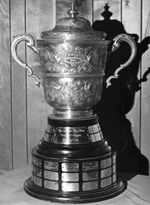 A highlight of many students' college career is competing at the National Collegiate Dairy Judging contest, now held at World Dairy Expo. The coveted Otto Schnering Trophy has been awarded to the National Champion since 1953. Each year the winning team's college is engraved on the award, which is on permanent display at the National Dairy Shrine.
A highlight of many students' college career is competing at the National Collegiate Dairy Judging contest, now held at World Dairy Expo. The coveted Otto Schnering Trophy has been awarded to the National Champion since 1953. Each year the winning team's college is engraved on the award, which is on permanent display at the National Dairy Shrine.In 2010, the second-tier wood platform was completely filled with team names. It became necessary to add another base to the antique Georgian silver punch bowl. While this may seem like a simple task, it was quite an extensive project. The silver bowl that sits atop the trophy was evaluated by Tom Pretty, who is a silversmith at Armbuster Jewelers in Cedar, Wis. and works with awards for clients like the Chicago Yacht Club. He shuttered to place a value on the fine artwork, but confidently believes the one-of-a-kind, hand-crafted creation is in the class of the Klussendorf Award, which was created by Tiffany's Jewelers of New York in 1937.
With such a "priceless" piece, it was carefully removed from the wooden base and polished to reveal its true craftsmanship. The wooden base was then joined to a larger wider base made of red oak, making the third platform of the 3 feet tall award. At a cost of over $1,000 for enhancements, the trophy is poised for another 54 years of champions. To be honest, it has never looked more impressive!

With dozens of teams traveling to World Dairy Expo for the national contest each fall, they can view the Otto Schnering Trophy during their time in Fort Atkinson, Wis. Since 1981, the award has become a permanent fixture at the museum, retiring the "traveling" aspect of the trophy due to its value. Since its short hiatus to upgrade the award, it is back on display at the National Dairy Shrine in the museum's recently renovated judging alcove.
As part of the precontest preparations, judging teams visit farms and local attractions in Wisconsin. The Sunday prior to the contest, teams converge on Fort Atkinson. Evaluating three classes of Guernseys at the Hoard's Dairyman Farm, touring Nasco and exploring the Dairy Shrine Museum constitute their morning activities. While at the museum, teams can stand in awe of the trophy in the hopes their school's name will be added the following evening.
Who does this judging award commemorate?
Otto Schnering was the visionary leader of the Curtiss Candy Company Farms and the Curtiss Breeding Service of Cary, Ill. As a Chicago youth, he raised birds in his basement and spent summers in the Michigan countryside. After college, he worked in sales in the food supply business. And, at the age of 25, when a friend was out of work, he started making candy at night to give him a job. Two years later, that act grew into a company consisting of 44 employees making 81 different sweet-toothed favorites, including the well-known Baby Ruth and Butterfinger candy bars. His company was named Curtiss Candy Company after his mother's maiden name. Otto became known as an innovative leader of the confectionary industry and Curtiss became synonymous with quality ingredients and the highest sanitation standards.
Without a production animal background, but a deep appreciation for agriculture, Otto set forth to impact various aspects of food production. He purchased land and registered breeding stock representing 11 breeds from four species (dairy, beef, swine and sheep). He built prominent herds and flocks from all he touched.
His A.I. company was built from the belief that it was important to "make superior seed stock available to farmers who need it." He was grateful to those who produced the quality ingredients, like milk used in his milk chocolates, upon which his success was built.
His wife, Dorothy, was well-versed in his varied operations and also had a strong business-mind herself. After Otto's death in 1953, she assumed control of his A.I. company, expanded it and generated profits that were then used to aid the struggling candy company. It was that very year that the Otto Schnering Trophy was first awarded to the 1953 National Championship team from Washington State University.









